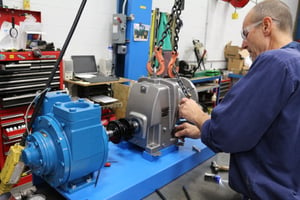At Professional Pump, we know the frustration of a self-priming pump that won’t prime. These pumps...
Optimize Your Pump Performance With Preventive and Predictive Maintenance

Reactive maintenance, or fixing equipment only after it breaks, often leads to unexpected downtime, emergencies, and costly repairs. A more effective approach combines preventive and predictive maintenance to enhance pump reliability and minimize disruptions.
Understanding Preventive and Predictive Maintenance
Preventive Maintenance (PM) involves scheduled tasks to keep equipment in good condition. This includes routine activities like calibration, lubrication, and alignment. Ensuring proper alignment and balance is critical, as misalignment and unbalance can cause significant issues, such as increased vibration and premature component failure.
Predictive Maintenance (PdM) focuses on monitoring equipment conditions to predict potential failures before they occur. Techniques like vibration analysis help track changes over time, allowing for planned repairs and avoiding unplanned downtime.
Creating an Effective Maintenance Program
Categorize Pumps: Not all pumps require the same level of maintenance. Classify pumps as Critical, Essential, or Non-Essential to determine the appropriate maintenance strategy. Critical pumps require the most attention, while Non-Essential pumps can have less frequent checks.
Implement Regular PM: Regular maintenance extends pump life and prevents costly breakdowns. Key tasks include checking bearing temperature, lubricant levels, vibration, and alignment. For oil or grease-lubricated equipment, change the lubricant every three months or 2,000 hours.
Utilize Laser Alignment: Misalignment can lead to significant damage. Laser alignment offers the most accurate method for aligning pumps and motors, improving long-term reliability.
Consider Precision Rebuilds: Rebuilding pumps to OEM specifications can reduce failures and extend their lifespan. If in-house resources are limited, seek a local shop like Professional Pump.
Ensure Proper Installation & Start-Up: Proper installation and start-up procedures are crucial. Follow guidelines for lubrication, alignment, and performance baselines to ensure optimal operation.
Monitor Vibration: Vibration monitoring can predict failures and help maintain equipment health. While it requires specialized training, technologies like ITT's i-Alert2 offer continuous condition monitoring and alerts.
Invest in Training: Training is essential for all staff interacting with pumps. Educate operators and maintenance teams on recognizing failure signs, proper start-up/shut-down procedures, and the impact of their actions on system performance.
Seek Expert Assistance: Some maintenance tasks require specialized skills and equipment. Consider hiring experts at Professional Pump for tasks like advanced vibration analysis or precision rebuilds.
By integrating preventive and predictive maintenance strategies, you can reduce maintenance costs and avoid unexpected downtime. You can download a preventive maintenance checklist to learn how to create your own pump reliability plan. The Professional Pump service team is here and ready to support you with your preventive and predictive maintenance programs throughout Michigan and Northwest Ohio.




